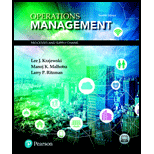
Concept explainers
A
Interpretation: The average utilization rate of the secretary should be calculated.
Concept Introduction: Utilization rate is average the time spend by a person in productivity activity. It is calculated as percentage.
B
Interpretation: The probability for the page waiting or processed should be calculated.
Concept Introduction: Waiting line model is used to calculate the performance. The probability in a waiting line requires to wait for service.
C
Interpretation: The average number of pages is to be processed.
Concept Introduction: Waiting line model is used to calculate the performance. The probability in a waiting line requires to wait for service.
Want to see the full answer?
Check out a sample textbook solution
Chapter B Solutions
Operations Management: Processes and Supply Chains (12th Edition) (What's New in Operations Management)
 Practical Management ScienceOperations ManagementISBN:9781337406659Author:WINSTON, Wayne L.Publisher:Cengage,
Practical Management ScienceOperations ManagementISBN:9781337406659Author:WINSTON, Wayne L.Publisher:Cengage,
